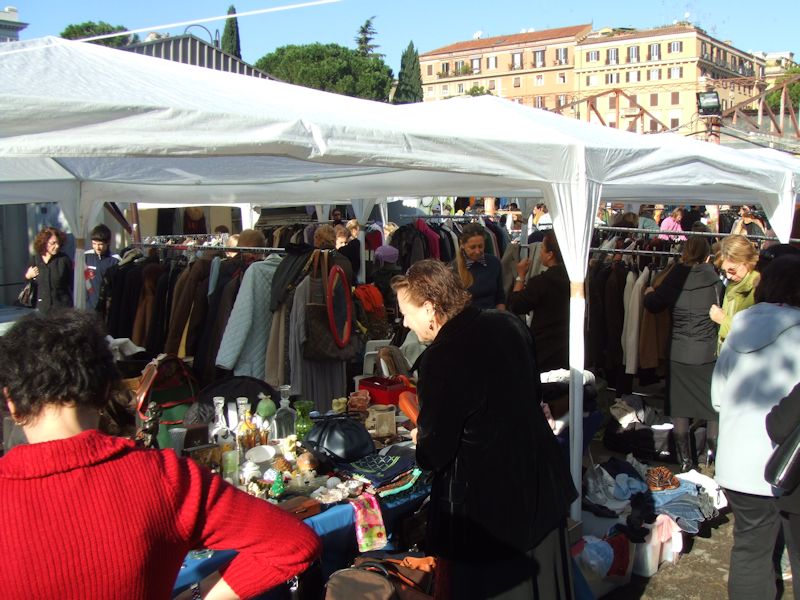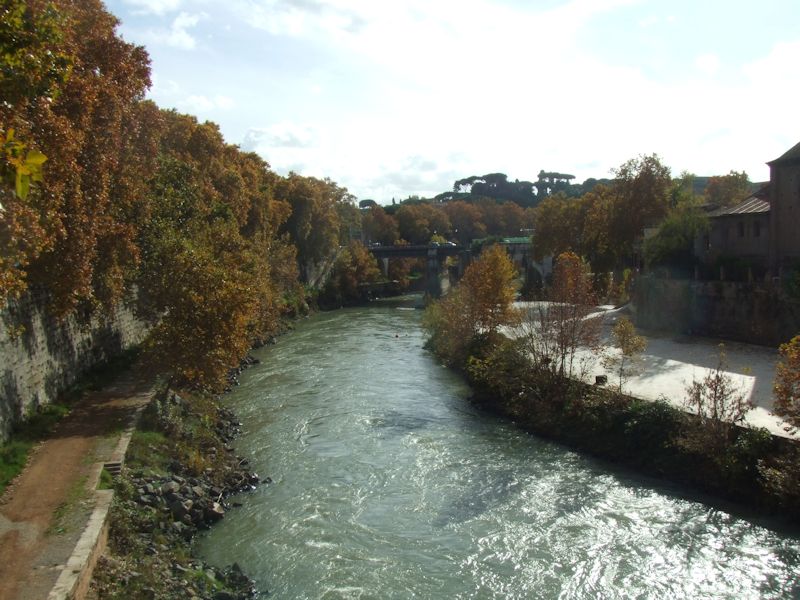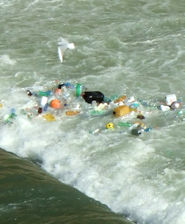Kristin
spent the better part of ten years poking about in Rome,
Italy, and has generously offered to show us everything, about Rome that
is, if we'll just dedicate a week to not missing a single bit of it. At a dead
run, if necessary.
So
let's do it!
The Rome record for one week's dedicated walking and viewing-with-cultural-appreciation
is something like 48 palazzos, 62 solemn museums, 123 ancient churches and 4 brand-new
ones, 27 famous fountains, 6 antique markets on Sundays, 1 big colisseum and 1
not-to-be-missed Forum, and a lot of panini. We're off!
You
may not find this terribly rewarding unless you're included here, so this is a
good time for casual and random browsers to turn back before they get too caught
up in the sweep and majesty of the proceedings and can't let go.
A whirlwind visit to Rome

A
pre-dawn flight on EasyJet and here we are at our apartment for the week, at 4
Vicolo de Cedro in the Trastevere district, 15 November 2006, dawdling outside
the fortress gates, browsing through the International Herald Tribune, awaiting
the agent's arrival to let us in and brief us on the utilities and garbage collection
days.
(The
graffiti is everywhere and nearly always completely
senseless. A bad omen for Rome's future when these senseless people reach adulthood.)

A
lovely old pad we've got here, too. All the mod cons and not terribly expensive.
There's a courtyard out the back, but we never used it, since we were required
by the Agenda to spend 14 hours on the hoof out at
the museums and palazzos. The kitchen nook was very serviceable and, in fact,
Kristin cooked up a formidable dinner for friends on 20 minutes' notice there,
whilst the rest of us were catching up on the International Herald Tribune on
the sofa. One thing about the flat, though: the shower really sucked.

The
Vicolo de Cedro, outside our flat (the Cedro is overhanging in the centre): we're
off up the hill to see some of the sights.

The
view out over Rome from the Gianicolo hill behind our flat in Trastevere.

That's
Hadrian's Mausoleum down there on the left, the Castel Sant'Angelo, where the
popes could go when vexed and hide out from pre-Protestant marauders bent upon
plunder and slaughter. There's even a fortified walkway from the Vatican along
which medieval popes could scurry, clutching their booty, and wait their troublesome
subjects out.

The
mighty Tiber slouching towards the sea at a leisurely pace, gliding under all
the Tiber bridges with their derelict fellows camped underneath, with all their
woolens and pots and pans gathered about them.

Angels
on the bridge, lost denizens underneath it, and a bicycle path all along the way.

And
here's the Tiber from somewhere up on top of the Castel Sant'Angelo. About 90
degrees off to the right is the fortified raised passage leading to the Vatican,
providing easy refuge for the pope with his bagfuls of booty and tons of dimes
and quarters from all the collection plates around the world. There's a row of
great Snack Wagons down along the street.

St
Peter's from the Castel Sant'Angelo. You can see why a fortified bolthole would
have been needed, in the turmoil of medieval times. Nobody wants to have to watch
the pope lumbering down that road with his heavy gilt robes on, clutching fistfuls
of jewels and rare perfumes, with eight or ten Cardinals with their own big backpacks
trying to beat him to the fortress door before the guards slam it shut against
the populace.

Once
inside that thing, any pope ought to be able to relax and enjoy his lovely stuff
whilst the populace gnashes its teeth outside. The Roman Emperor Hadrian (died
in 138) came from Spain but so wanted to settle down in Rome that he built the
original monstrosity to seal his residence forever, and the tremulous popes, naturally
always very uneasy about their hold on the religio-civic myth, built it straight
up and outwards as a palatial hideout when needed.
(The
January 2007 issue of History Today has a good article on "Hadrian's Hall",
by Charles Freeman, and its "fabulously rich and complex history" --
it's worth reading.) (We took the opportunity of another visit to the Castel in November 2022 to put up photos for a more thorough look at the interiors.)

Schoolkids
waiting for the Andy Warhol exhibit to open. Oh well, they're just kids.

Kristin
chagrined to find Bernini's Four Rivers all boarded up for renovations. We're
in the Piazza Navona, just outside the church of Sant'Agnese in Agone, and we'll
be back later in the week for a nice concert with counter-tenor.

Our
favorite grocery, with lots of cheeses, lots of wines, and lots of exceptional
beers, is right round here somewhere.

Kristin
pausing in the loggia of the Palazzo Farnesina to read up on Palestinian history
prior to the occupation in 1948.

St
Peter's, where popes have been coming and going like ants in a terrarium for nearly
two thousand years. Except when they were sequestering in Avignon, France, and
hiring contract killers to pick off their 14th-century competitors. [The popes officially moved into the Apostolic Palace and St Peter's in the Vatican, from the Lateran Palace in Rome and various hideouts around Italy and France, in the late 15th century.]

St
Peter's, cynosure of the Whole World for a pious
segment of the world's population -- not so much in Italy, mainly in the Philippines,
Guatemala, and the USA -- but for Italians a major money-maker. Famous architecture,
but some among us might see similarities with the main Stalinist railroad station
in a provincial city in the Soviet Union. Monumentalism run wild. Shameless self-aggrandizement!
Except for the elegant dome.

Some
pretentious colonnading in advantageous lighting, with a lot of officious papal
security guards in cast-off East German uniforms who tried to take my tiny Swiss
Army Knife off me just to get in to see their somewhat-overdone Christian church.
Naturally, my response was . . . well, not to go into that, but anyway I hid my
wee little Swiss Army Knife under some elaborate papal furnishings built off the
earnings of the poor and got back on line to get in to see some of the Pope's
bling-bling.

The
Spanish Steps. We're scurrying past, looking for a grocery that's got some more
of that great micro beer. I'm sorry that I can't remember the name of it, but
it had a label on it with an old Italian gentleman with a nice green felt hat
looking forlorn.
(Update: Birra Moretti)

The
Tiber Island (like "Starship Tiber" gliding into the spaceport)

Kristin
at auditions in the Theatre of Marcellus

Near
the Theatre of Marcellus. We're meant to observe this ancient evidence of the
Roman habit of scavenging -- earlier Roman columns now stuck into the upper walls
horizontally to make up the difference. It appears that every late-Roman or medieval
church in the city has got its central columns all mismatched -- as they were
all ripped off catch-as-catch-can from ancient Roman buildings left abandoned
when the terrorists came.

A
nicely-lit view from Marcellus (more photos can be seen here from our visit in November 2022)
St
George's church, San Giorgio, in Velabro, blown off its hinges by the Mafia in
1993, but nicely put back together again.

Near
the Roman Forum

Views
from within the Roman Forum area

Interesting
old stonework (viewed whilst awaiting friends outside the public loo)

Kristin (foreground) was kindly reading out long passages from the guidebook for
us, but a lot of it went right past -- it was such a dreamy summer's day (albeit
in late November).

The
arch of Emperor Septimius Severus, we got that much, I think.

We're
still in the basic Roman Forum area, that's my understanding of it so far.

That
looks like Septimius Severus again. Those of us who've tried to teach Historiography
using Roman historians -- like Livy, Tacitus, Suetonius, Plutarch, Sallust, and
Polybius -- in college classes in the USA have a perfect right to be thrilled
to see these ancient famous names brought to life again -- well, not so much brought
to life -- at least, still around after all these years. Actually, we're looking
out for one of those Snack Wagons that have got the convenient flat/round
kind of panini for next to no cost.

A
general view of the Forum, there are no panini wagons in this direction, so we'll
go out by the Colisseum.

The
Roman Colisseum (looks just like the postcard), quite large, and probably worth
the time spent tramping up the ancient stone stairways to peer out of the upper
stories. But not today, we're in a great rush to see TIMELESS
WORKS OF ART and find a Snack Wagon.

Frankly,
with a modern smaller-is-better mindset, we found Nîmes in France and El
Djem in Tunisia somewhat more appealing, and this thing looks just such a wreck
anyway, that we'd rather hurry on and tick off a few more palazzi and medieval
churches before Happy Hour today. We still need to find a Snack Wagon pretty quick.

Three
Roman soldiers and a tourist. It's better that we don't ask what this is really
all about. Or who those weird guys are when they're not being Ancient Romans.
The one who looks just like Berlusconi is actually a stand-in for the weekends.

A
serious police presence for a demonstration calling for increased child care facilities.
Just in case those enthusiasts for increased child care facilities start throwing
petrol bombs and trying to burn down the Parliament. Helicopters were circling
overhead all day. In case those increased-child-care enthusiasts tried to call
in air support. We were wolfing down lovely pizza-panini and marveling at how
civilized all these people are.
There
seems to be about one police officer in Rome for every 2 or 3 citizens. The relationship
looks extraordinary -- in our nearby piazza of Santa Maria in Trastevere, every
evening at about 8 or 9 p.m., as the youths, drifters, and bangladeshi vendors
of luminescent toys began to gather, three Carabinieri automobiles drove into
the square and parked, and 12 Carabinieri got out to chat amiably with the municipal
policemen already on the scene and deployed leisurely around the square. No one
in the square altered their festive purpose or even showed the slightest concern.
It seemed to be a very expensive nightly police-hippy love fest.

Roman
ruins, the Temple of Vespasian, after a really good panino at the Snack Wagon.

A fruit and vegetables market at Campo de Fiore. There are no labels on the packets,
so it's impossible to tell if they're observing
the boycott on Israeli produce from the settlements.

From
viewing classy artworks in the Palazzo Colonna (I'm leaving out lots of palazzos
here, because they usually don't allow photographs), this is a view of Kristin's
son George's apartment last year (at the top, to the left of the palm tree or
whatever that is). We
asked permission to shoot this photograph but were denied, since you're not allowed
to take photographs in the gallery. I thought the matter over, however, and determined
that I was actually taking photographs OUT OF the gallery, so when the Security
Officer turned his back, VOILÀ!

Even
parking your car can be a culturally-uplifting experience in Rome.
(Depending
upon how uplifted you are by naked stone guys.)

Another
Snacks Wagon, in the Piazza de Venezia. They've got this wonderful panino,
flat pizza bread with odds-and-ends in it, like ham and cheese or whatever, and
they heat it up for you and sell you a water to go with it for next to nothing.
It's great for eating while walking around viewing ancient art works and palazzi,
though not as good as a Nathan's Hot Dog in that regard. It tastes something like
ham-scented cardboard, but of course there are always trade-offs. This
is what Western Civilization is all about.

That's
Kristin, behind the columns, somewhere in the Palazzo Venezia, studying art works
and planning our dinner for this evening.

The
Villa Borghese (by appointment only), late in the day. Lots of good stuff in there,
by the way, and the restrooms are clean.
My
absolute personal favorite (but no photographs were allowed) was the Villa
Doria Pamphili, hung with a gazillion paintings all over every available
inch of wall, and on the audiophone guide Mr Doria Pamphili himself, or someone
very like him, with a pleasant subdued British accent, described his ancient
family's heritage in the most humane and literate terms. That was a real treat
-- even when he was describing the part about the room of sculptures when the
roof fell in after a snowstorm.

Kristin
coming home with the shopping

A
mad dash back to the Vicolo de Cedro 4 in Trastevere to mix up a huge pile of
pesto for our guests Barbara and Ludovica, a welcome opportunity to discuss leftist
Italian politics with experts.

Kristin
out shopping. The Sunday morning what-you-may-call-it with all sorts of items
for sale. Savvy antique-buyers, like Kristin and her friend Ewa, cruise these
stalls with a quick and practiced eye, seeking things their owners may have not
understood rightly and priced wrongly.

Kristin's
good friend Ewa (blonde, center) is a master jewelry craftsperson and trader,
and she mixes up a great lunch as well.

This
is the relatively HUGE Basilica di Sant'Agnese in Agone in P. Navona, where we
learnt of a forthcoming concert by the Romabarocca Ensemble in the acoustically-gifted
Sacristy of Borromini inside, featuring the counter-tenor Mario Bassini, and we
came back here right after Happy Hour and had a very uplifting counter-tenor experience,
and then went for pizza.

The
Fountain of the Vomiting People

The
statue of Pasquino. It's been here for Yonks, near the Piazza Navona, with since
the 16th century political satires and rude political commentary stuck all over
it, and thus since the later 16th century we have had in English the word "pasquinade"
to mean a personal satirical attack on a politician.

Coming
back home to the Vicolo de Cedro in the evening, after a nice dinner.

Once
again, our kitchen, because it was very nice and cooked up the coffee water in
a jiff.

A
Dignitary's motorcade headed for St Peter's in the rain. Whoever this fur-lined
plonker was, he was late. The supersize screens in St Peter's square were already
showing for the plebian-crowds the somewhat overdressed pope, all got up in his
gilty robes and celestial hat, shaking hands with a long receiving line of the
Great&Good™ in fancy dress advancing by inches into the Double-Holy Sanctum
Sanctorum for an apéritif. (If you want to make an honest living as a diplomat
in irrelevant places, you've got to be prepared to dress up and grin through this sort
of thing regularly.) So this motorcade-jerk had to get on the end of the line
where he belonged.

Here
we are at the repository of the earthly remains of the Guy
Whose Name was writ in Water. Keats
was English, thus Established Church, thus Not Roman Catholic, thus Not Eligible
for Burial Within the City Walls, so here he is in the Foreigners' Cemetery --
outside the Roman city walls. What a sad fate for a young kid with 6 to 8 first-rate
poems and a massive lot of pennywork.

Shelley's
here, too. And so is Shelley's little son with Mary Wollstonecraft. For dead poet
associations, this is the place to be. The lines from The Tempest are,
of course, just wishful thinking.

Kristin
prefers the early 19th century Norwegian diplomats with unpronounceable names.

This
is My Main Boy in Rome. Pio Nono, our longest reigning
pope (1846-1878), now presiding in Santa Maria Maggiore (Cardinal B. Law's hide-out
after Boston showed him out the door). The sculptor caught him perfectly and did
him no favors. He really does look like The Guy Who Got
the Loot and You Can't Get It Back! "Thanks
again, Lord, for Everything, heh heh heh!"

Pius
IX, fairly smirking for lots of reasons, some of which will probably never be
known, is the modest individual who got himself declared INFALLIBLE
at the first Vatican Council in 1870. ("Infallible" includes: no tax
audits.)

Santa
Maria Maggiore

The
Flatiron Building of Rome

Santa
Maria Maggiore from the 'hood

Roman
street scene

Kristin,
in beatific surroundings, clutching our dinner

Infrastructure
maintenance in the Roman style

A
Roman-era capital in the ghetto neighborhood above some shops displaying Israeli
propaganda

Half
of the Tiber alongside the Tiber island

The
mighty Tiber by Tiber island, with the Ponte Rotto ("Busted Bridge",
frequently busted since its creation in 179 B.C.) and its modern successor, the
Ponte Palatino

















































































